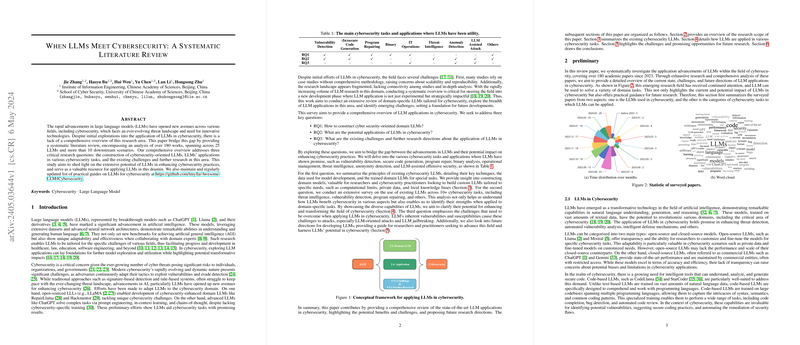Overview of LLMs in Cybersecurity
The paper "When LLMs Meet Cybersecurity: A Systematic Literature Review" presents a comprehensive review of the interplay between LLMs and cybersecurity. The paper encompasses an analysis of over 180 academic papers, scrutinizes 25 LLMs, and explores more than 10 downstream cybersecurity scenarios. This thorough investigation aims to address how LLMs can be adapted and applied across various cybersecurity tasks, identify challenges within the domain, and propose future research directions.
Construction of Cybersecurity-Oriented LLMs
The researchers provide an adept overview of constructing domain-specific LLMs for cybersecurity. Primarily, this involves using techniques like continual pre-training (CPT) and supervised fine-tuning (SFT) on existing LLMs. CPT is employed to further refine models using large volumes of cybersecurity-specific datasets without explicit labels, while SFT utilizes labeled data to enhance task-specific performance. Technical practices such as parameter-efficient fine-tuning (PEFT) are emphasized for their computational efficiency. The choice of a base model, reliant on robust evaluations of cybersecurity capabilities, forms a critical step in constructing apt models for the domain.
Applications of LLMs in Cybersecurity
The paper elucidates multiple applications of LLMs in cybersecurity:
- Threat Intelligence: LLMs assist in automating the extraction and summarization of cyber threat intelligence from vast knowledge repositories, contributing valuable insights to threat detection mechanisms.
- Fuzz Testing: LLMs enhance traditional fuzzing techniques by generating intelligent test cases, improving the effectiveness of identifying software vulnerabilities.
- Vulnerability Detection: Models demonstrate promising results in detecting code vulnerabilities, although challenges like false-positive rates persist.
- Secure Code Generation: Examination of LLM-generated code for security flaws reveals that models can generate secure code but require further advancements for better robustness.
- Program Repair: LLMs facilitate program repair by automatically diagnosing and fixing software bugs, surpassing many traditional techniques in effectiveness.
- Anomaly Detection: LLMs are employed for detecting security anomalies such as malicious traffic, showcasing their utility in identifying early threats.
- Attack Assistance: While LLMs offer benefits in cyber defense, they also present potential risks when exploited for generating malicious content, like phishing emails.
Challenges and Research Directions
Despite their potential, the application of LLMs in cybersecurity is fraught with challenges. LLMs face vulnerabilities including backdoor and prompt injection attacks, as well as jailbreaking risks where models generate unintended outputs. These challenges underscore the need for enhanced security measures in deploying LLMs in cybersecurity.
The paper proposes bolstering LLMs with tool-use and API call capabilities, developing intelligent agents that autonomously understand, plan, and execute complex tasks. These agents can profoundly influence the future of cybersecurity, significantly enhancing the capabilities of cybersecurity operations.
Conclusion
This literature review serves as a pivotal resource in bridging LLM advancements with the pressing demands of cybersecurity. By exploring how LLMs can be tailored to address specific cybersecurity needs, it lays a foundation for ongoing research in developing adaptable, intelligent, and comprehensive cybersecurity strategies. The integration of LLMs in cybersecurity promises significant advancements, provided the inherent vulnerabilities of these models are rigorously mitigated.
